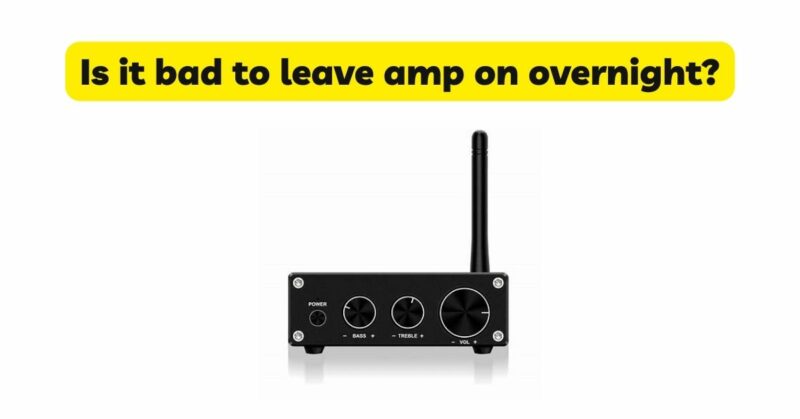The practice of leaving audio equipment, including amplifiers, turned on overnight is a subject of debate among audio enthusiasts. Some argue that leaving the amplifier on continuously can have negative effects on its performance and longevity, while others believe it poses no harm. In this article, we will delve into the question of whether it is bad to leave an amplifier on overnight. By examining various factors and practical considerations, we aim to provide clarity on this topic.
I. Understanding the Concerns:
- Power Consumption: One of the primary concerns associated with leaving an amplifier on overnight is increased power consumption. Continuous operation can lead to unnecessary energy usage, resulting in higher electricity bills and environmental impact.
- Component Wear: Another concern is the potential wear and tear on the amplifier’s components when operated continuously. The prolonged operation can lead to increased heat generation, which might affect the lifespan of sensitive electronic components.
II. Examining the Amplifier’s Design:
- Modern Amplifiers: Most modern amplifiers are designed with built-in protection mechanisms to mitigate the potential risks of continuous operation. These protections include temperature sensors, current limiting circuits, and automatic shutdown features to prevent excessive heat buildup or component damage.
- Class D Amplifiers: Class D amplifiers, known for their efficiency, generate less heat compared to traditional Class A or Class AB amplifiers. As a result, leaving Class D amplifiers on overnight may have a minimal impact on power consumption and component wear.
III. Practical Considerations:
- Heat Dissipation: Adequate heat dissipation is crucial for the amplifier’s longevity. Ensure that the amplifier has proper ventilation and is not placed in enclosed spaces or near heat-generating sources that could impede its ability to dissipate heat effectively.
- Usage Patterns: Consider your usage patterns and how frequently you listen to music. If you frequently use your amplifier, turning it off during periods of inactivity may help conserve energy and reduce wear on the components.
- Manufacturer Recommendations: Refer to the amplifier’s user manual or consult the manufacturer’s guidelines for specific recommendations regarding leaving the amplifier on overnight. Some manufacturers may provide explicit instructions or suggestions on powering off the amplifier during extended periods of inactivity.
IV. Energy Efficiency:
- Standby Mode: Many amplifiers have a standby mode that allows them to consume significantly less power while remaining in a low-power state. Utilizing the standby mode when the amplifier is not in use can help reduce power consumption without the need to power it off completely.
- Energy-Saving Practices: Implementing energy-saving practices, such as using power strips with individual switches or smart plugs, can provide more control over the amplifier’s power usage. These tools allow you to easily turn off the amplifier and other peripheral devices when not in use, minimizing standby power consumption.
V. Personal Preferences and Considerations:
- Convenience: Leaving the amplifier on overnight may offer convenience, as it eliminates the need to power it on and wait for warm-up periods each time you want to listen to music.
- Environmental Impact: Consider the environmental impact of leaving the amplifier on continuously. If reducing energy consumption aligns with your values, powering off the amplifier overnight may be a practical choice.
VI. Conclusion:
Leaving an amplifier on overnight is a matter of personal preference and practical considerations. While concerns about power consumption and component wear exist, modern amplifiers are designed with protections to mitigate these risks. By considering factors such as heat dissipation, usage patterns, manufacturer recommendations, and energy-saving practices, audio enthusiasts can make informed decisions that align with their priorities and strike a balance between convenience, performance, and energy efficiency.


